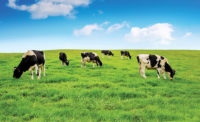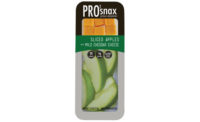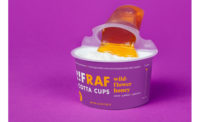Snack attack: Portable cheese snack options are on the rise


Alouette Cheese focused on snacking and unique flavor combinations with its two new cheese products, and both are low-calorie as well.

Sargento and Borden jumped on the portable snack trend, creating snack packs that pair cheese with pretzels, nuts and dried fruit.

Sargento and Borden jumped on the portable snack trend, creating snack packs that pair cheese with pretzels, nuts and dried fruit.

Trugman-Nash LLC, Millburn, N.J., launched Croc Bites, snack size portions of the company’s Old Croc Australian sharp Cheddar cheese. The individually wrapped 3/4-ounce portions are 90 calories each.

Individually wrapped and on-the-go cheeses are all the rage, as the mini concept continues to grow across all categories. Tillamook has spicy flavors of cuts for adults, and Jarlsberg added a light version of its mini wheels.








Wander through the grocery store today and you will see plenty of new snack options on display. You can find cheese paired with meats, nuts, dried fruit, and crackers or pretzels. You’ll find snack-sized portions of cheese, grab-and-go yogurt, and even cream cheese designed for on-the-go lifestyles. Processors I spoke with cite studies saying snacks represent half of all eating occasions. Half. That’s significant and should suggest a focus for new product development.
The snacking rundown
This change in eating occasions can be attributed to increasingly busy and on-the-go lifestyles which have reshaped consumers’ eating patterns in the United States. Meal patterns that include multiple snacks throughout the day are now widely accepted as the new normal, said Chicago-based Mintel, in an April 2015 report.
According to Mintel’s July 2015 report on hybrid products, as snacks start to take the place of meals, and as U.S. consumers become more health aware, a new group of snack products that crosses the lines between snacks and meals are coming to the market.
“What was once something eaten between meals is at times, today, the entire meal,” said James Robson, the CEO of the Wisconsin Milk Marketing Board, Madison.
Mintel’s report also indicated that it’s not necessarily the type of food that makes it a snack, but the food’s presentation. A third of the consumers surveyed agree that there are not enough conveniently packaged snacks (e.g. individual portions or resealable packages). Even more important, 77% prefer ready-to-eat snacks over those that have to be heated or prepared. Convenient packaging is a key element of snack kit product innovation and design. Kits touting high protein are now combining foods in compartmentalized or component-style packaging for on-the-go lifestyles, according to Mintel.
The report also revealed that 70% of U.S. snackers agree that “anything can be considered a snack these days.” And, as Mintel noted, this gives manufacturers an opening to expand the horizon for packaged snack products, and to include a range of ingredients, such as cheese.
Consumers’ desire for convenient, ready-to-eat snacks, combined with the sentiment that “anything can be a snack” gives manufacturers a broad mandate to develop cross-over and hybrid products that suit the needs of the consumer, concluded Mintel.
All of this is really good news for cheese manufacturers. This creates a plethora of opportunities for dairy processors to develop new products that focus on convenience and portability with an emphasis on high protein and snacking. Some processors have already taken advantage of this, answering the call with innovative new snack packs and snack sizes.
New product innovations
Christopher McCarthy, director of marketing at Sargento Foods, Plymouth, Wis., said, “Snacking has become a very important part of how consumers eat, for millennials in particular.” He added that consumer interest in protein “shows no sign of slowing.”
Offering a quick protein option was the goal behind Sargento’s Balanced Breaks, a snack pack combo of natural cheese, roasted nuts and dried fruits. The 1.5-ounce individual-sized trays are sold in the dairy case in a 3-pack and come in four varieties, including natural white Cheddar with sea-salted almonds and dried cranberries; and natural sharp Cheddar with sea-salted cashews and cherry-infused cranberries. Each serving pack contains 7 grams of protein and less than 200 calories.
Along with busy lifestyles, the desire to get more high-quality protein into consumers’ diets is also playing a part in the snacking trend.
Robson said, “According to IRI data, claims about protein rank 5th among growing content claims due to the fact that more than half of consumers are actively trying to increase their protein intake and cheese is well positioned for consumers’ increased desire for protein in their diets. We’re seeing a number of products developed over the past couple of years that take advantage of this and promote the protein inherent in cheese.”
“There is a lot of interest in protein from consumers, but also from nutrition experts,” said Laura Fischer, brand manager for Mini Babybel at Bel Brands USA, Chicago. “Research has been showing that protein helps with feeling satisfied after eating and helps support healthy muscle, skin, nails and hair. Some experts are even suggesting the recommendations for how much protein to eat may be too low.”
Indeed, nutritionists are now suggesting it is ideal to get 20 to 30 grams of high-quality protein per meal. Some could find this difficult to achieve, which is why snacking (and snacking on good, high-protein snacks) plays an important role.
Borden Cheese, Kansas City, Mo., and Dairy Farmers of America, Kansas City, Mo., teamed up to introduce a high-protein snack called Good2gether. The snack trays, which combine natural cheese and mini-twist pretzels, contain 11 grams of protein per 2.05-ounce package. Good2gether is available in four varieties, like mild and sharp Cheddar, and features cheese cubes in one compartment and pretzels in the other.
Mini and portable cheeses
According to Robson, “IRI data reveals that snacks are outperforming the CPG [consumer packaged goods] category as a whole in all channels. Additionally, research we’re seeing from NPD Group Inc. places string cheese in the top 10 snacks for two of the three day-parts studied – morning and afternoon snacks. String cheese is the most popular snacking cheese and is one of the fastest growing snacks with what’s considered a ‘health’ halo.” The NPD Group, Rosemont, Ill., provides market information and advisory services.
Robson added, that “many Wisconsin cheese companies have answered the demand with new products, ranging from premium string cheeses to snack-sized brie wedges and crunchy cheese snacks.”
For companies like Bel Brands, which has offered snack options for a while (like its Mini Babybel cheeses, which contain at least 4 grams of protein per 0.75-ounce wheel), calling out protein on packaging or in ad campaigns is important.
“In the past few years, Bel Brands has noticed consumers’ desire to understand the amount of protein and calcium in [its] snack products. To appeal to this, the brands have incorporated the FDA-approved level of protein and calcium in product messaging, packaging and advertisements,” said Fischer.
And they aren’t the only ones making this change.
“We added protein per serving information to the front panel of our packaging where this information is most important to consumers,” said Laurel Miller, category manager at Tillamook Cheese.
Tillamook County Creamery Association, Tillamook, Ore., developed a new line of snack sticks (aimed at kids of all age groups) in milder cheese flavors (medium Cheddar and Colby Jack) with what it described as “more playful packaging.” The company also offers a line of individually wrapped cheese portions called Tillamoos that are geared toward adults. These 0.75-ounce rectangular cuts come in flavors like sharp white Cheddar, hot habanero Jack and smoked black pepper white Cheddar. Both the sticks and the rectangle cuts contain 5 grams of protein per serving (one stick or rectangle).
Jarlsberg Cheese (a Norseland Inc. brand, Darien, Conn.), introduced a lite version of its individually wrapped Minis this year. Each 20-gram (0.7-ounce) portion contains 7 grams of protein. Its original Minis contain 5 grams of protein.
“The mini concept is growing across all categories, not just dairy products, so we expect to see marked growth,” said Debbie Seife, general manager of marketing at Jarlsberg Cheese. “Additionally, we have a population that is continually focused on health and smaller portions of the foods they like best.”
Seife continued, “The snacking space is a billion-dollar category. The deli snacking category continues to grow year over year. Consumers want wholesome back-to-school foods for their children…and the convenience of on-the-go snacking.”
Crave Brothers Farmstead, Waterloo, Wis., also added new products to its line this past summer that fit into the snacking category — Farmer’s rope mozzarella sticks in an 8-ounce package and 12-ounce bags of fresh Cheddar cheese curds.
“We knew we needed sizes and packaging that you can eat in the car on the way home from the grocery store, or pull out of the fridge and take to a sporting event,” said Debbie Crave (vice president) and George Crave (president).
Alouette Cheese, New Holland, Pa., focused on snacking and flavor innovation with its new cheese products. The company launched two low-calorie cheese snack options – Le Petite Fromage (portioned flavored cheese spreads) and Le Bon Dip (cheese and chunky vegetable dips).
Le Petite Fromage contains 40 calories and 2 grams of protein per individual portion (approximately 0.59-ounces). It comes in four varieties, including cucumber and dill, and garlic and herb. It’s sold in a 4.7-ounce package containing eight individually wrapped portions. The Le Bon Dip contains 50 calories or less and 2 grams of protein per 2 tablespoon serving, and comes in varieties like basil, zucchini and parmesan and zesty garden salsa.
Tameika G. Miller, senior brand manager at Alouette Cheese, New Holland, Pa., said that as the snacking trend continues and as consumers’ needs change (i.e. more nutritional demands, a desire for less-processed foods and more wholesome choices),” this will continue to “inform Alouette’s innovations.”
These snack trends and demands of consumers should inform a lot of future innovations and not just with cheese, but other dairy products as well. Snacking, it seems, is here to stay.
Looking for a reprint of this article?
From high-res PDFs to custom plaques, order your copy today!













